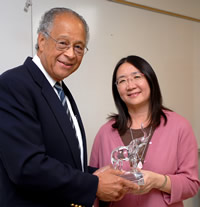Outstanding Professor Lecture
Intercultural Conflict Face-Negotiation Theory: A Researcher's Journey
April 7, 2009
By Valerie Orleans

President Milton A. Gordon presents Stella Ting-Toomey with her Outstanding Professor Award. Photo by Kelly Lacefield
On Monday, April 13, beginning at 11 a.m., Stella Ting-Toomey, professor of human communication studies, will present her Outstanding Professor Lecture on “Intercultural Conflict Face-Negotiation Theory: A Researcher’s Journey.”
The public lecture will be held in Portola Pavilion of the Titan Student Union.
Ting Toomey is perhaps best known in her academic field as the scholar who developed the theory of face negotiation that deals with how people from different cultures respond when placed in conflict. While conducting research as a doctoral student at the University of Washington, she discovered most research was biased toward Western viewpoints on conflict management.
“Western cultures tend to be very open and, as such, westerners are direct. They want to address conflict that might exist,” she explained. “Individualism is celebrated and there tends to be more likelihood of what I call ‘self face,’ where the individual is primarily concerned with his/her own interests.
“In many Eastern cultures, there is what is called ‘other face,’ where they strive to be more accommodating and to create a mood of harmony. Problems are not necessarily addressed in such a direct manner because it is believed that doing so would cause the other person to feel uncomfortable. This, however, can seem evasive to those used to a Western-style approach.”
Westerners may expect quick answers and direct eye contact. There is more autonomy and focus on individual actions. Easterners, who may be exhibiting ‘other face’ may make excuses for members of their group in order to help them save face. When Westerners persist in direct communication, Easterners may feel that they are being treated disrespectfully and their wishes are not taken into consideration.
“I’ve seen this even with my students,” she said. “If a classmate is late, they’ll say, ‘Well, he has a long drive,’ or ‘She had to pick up her children.’ They’ll make excuses for their peer’s behavior. It doesn’t necessarily benefit them personally but the goal is to help their classmate save face. That is a prime example of ‘other face.’
“The goal of these encounters is to develop what I call ‘mutual face’ where each side understands the other and their communications styles and they can reach a consensus,” she said. “The trick is to focus on the common goal. There is a reason that these two sides are being brought together so if you focus on that, discussions will be less polarized.”
Of course, Ting Toomey is quick to point out, everyone’s personality also comes into play during communications encounters. “We have to be careful not to stereotype but you do tend to see common elements in communications styles based on culture and values. Cultural differences are human differences and so situational factors also influence how you communicate.”
The key to good intercultural communication is mutual respect, Ting Toomey believes. “You need to practice mindfulness so you’re anticipating how you might come across to someone who has different values or perceptions. Look not only at what people are saying but how they are saying it. Look for non-verbal clues. And, if you think you’ve made someone uncomfortable, step back and reframe your position.
“The key is to demonstrate respect for one another,” she said. “Be aware of how you are coming across to others and, modify or at least explain your approach if necessary.”
Ting-Toomey’s April 13 talk is sponsored by the offices of the President and Vice President for Academic Affairs, President's Associates, Academic Senate and Faculty Development Center.

